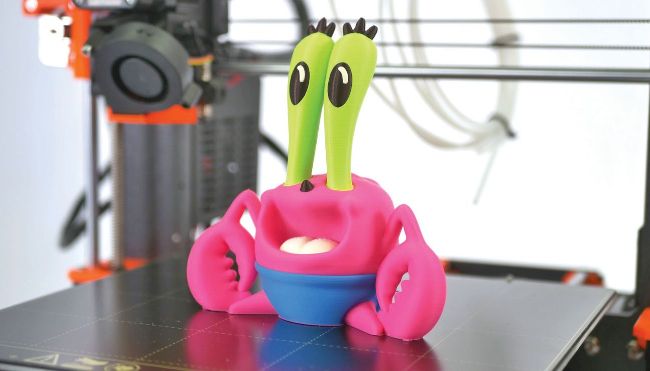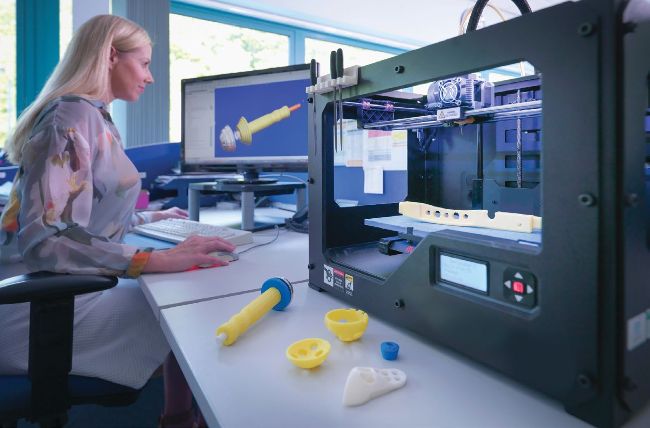JUMPING INTO THE WORLD OF 3D PRINTING
New to 3D printing? Want to advance your skills? Kris Butterill shows you the ropes
MOST PEOPLE have at least heard of 3D printing by now. Not everyone, however, fully understands what it is, how it works, what can be created, its limitations, or even how 3D printing is driving technological advancement throughout the world and changing our everyday lives. 3D printing has exploded in popularity over recent years, and with the technology becoming more affordable, it’s now more accessible than ever. 3D printing is an ever-growing platform for many hobbyists, enthusiasts, and professionals alike, and is a technology that offers a feature set like no other.
We are talking about a technology that is being used in a vast variety of fields, from product prototyping and construction to medicine, including customized prosthetics, orthotics, and more. It’s a process that is truly changing people’s lives for the better and, in most cases, is driving to reduce the by-products and waste created in manufacturing.
We want to guide you through the fundamentals of 3D printing, and how to get started, should you be in the market for a 3D printer. Maybe you just want to tinker, replace a broken part that can no longer be purchased off the shelf, prototype an idea, or simply play around and print cool things. No matter what your use case, delving into 3D printing can be a little daunting—trust us, we’ve been there. So, let’s get started with the basics….

Everything from prosthetic limbs to cartoon characters can be created with a 3D printer.
© GETTY IMAGES/LUCY LAMBRIEX , PRUSA
WHAT IS 3D PRINTING?
To start off, let’s cover what 3D printing actually is. In simple terms, it’s a process whereby a solid object is created by what’s known as additive manufacturing, utilizing a digital file as a blueprint. A typical manufacturing process— milling, for example—is a subtractive manufacturing operation, where material is removed to create the desired object. This is a process that creates a lot of waste material; in some cases, it’s possible to recycle or even sell these by-products of manufacturing.
3D printing is the exact opposite, where material is added to create an object. And here’s the cool part: 3D printing can create more complex shapes, and in the process, reduce the amount of waste generated, because it only uses what it needs for the object itself and any support structure.

An orthopaedic medical product designer uses CAD to develop equipment on a computer before the final device is created using 3D printing.
WHO IS 3D PRINTING FOR?
Everybody. As we said in the intro, the technology is becoming more and more accessible and affordable for mainstream users. This is not a technology reserved for mass-market product manufacture, specialist roles or applications, or even medical progression; it truly is something that anyone can use.
Throughout the Covid-19 pandemic, 3D printing has been a huge resource for the production of PPE—respirator valves, face shields, and mask extenders, in particular. There was a rallying cry throughout the 3D printing community to help provide items during the shortages of PPE, and there are people, just like you, printing supplies to help out all over the world. Linus Sebastian, Joel Telling, and many other popular YouTube stars have all been involved in one of the largest 3D printing challenges of our time to combat these shortages. Using their reach, the community has been pulling together to do their bit, and it makes you realize that 3D printing really has reached every corner of the globe.
TYPES OF 3D PRINTERS
Hopefully, with what you have read so far, you are still curious about 3D printing, and would like to get involved and have a go at printing your first model. So, it’s now time to talk about the types of 3D printers available—there are other methods of 3D printing, but the ones we mention here are the most common. We have also included a few pros and cons for each, to give you a better understanding of what each type brings to the party.
• FDM An FDM printer, or fused deposition modeling printer, is most likely what you picture when thinking about 3D printing— they are hugely popular and, in the most part, known for their ease of use. An FDM printer works with a huge variety of plastics—or, as they are more commonly known, filaments—each with their own positive and negative characteristics. Filaments are typically available in 1.75mm diameter, and are presented like a reel of cable, feeding the loose end into the printer via a tube, to be heated and extruded. By extruding the plastic, each layer of a model is produced along an X, Y, and Z axis.